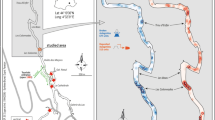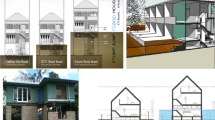Abstract
In situ preservation of archaeological sites has long been a concern for archaeologists. In recent years, considerable effort has been expended to identify appropriate technologies from other disciplines that are suitable for field implementation to protect sites that are experiencing various physical and human-caused impacts. This chapter provides an overview of many of these technologies, along with examples of application, and covers aspects related to management guidelines for addressing in situ preservation issues.
Similar content being viewed by others
References
Advisory Council on Historic Preservation, Treatment of Archaeological Properties: A Handbook (Washington, DC: U.S. Government Printing Office, 1980).
Allen, H.H. and C.V. Klimas, Reservoir Shoreline Revegetation Guidelines (U.S. Vicksburg, MS: Army Engineer Waterways Experiment Station, Technical Report E-86-13, 1986).
Amoroso, G.G. and V. Fassina, Stone Decay and Conservation (New York, NY: Elsevier Science Publishers, 1983).
Andropogon Associates, Earthworks Landscape Management Manual (Washington, DC: National Park Service, Park Historic Architecture, 1989).
Ardito, A.J., “Reducing the Effects of Heavy Equipment Compaction on Archaeological Sites”, Utility Construction and Maintenance (June/July 1993): 15-21.
Barker, D.B., “Stabilization Project: Santee Indian Mound”, CRM 15(2) (1992): 19-20.
Brown, M.K., “Mothballing Albany Mounds”, American Archaeology 3(3) (1983): 214-216.
Burke, W.J., Preservation of Davis Gulch Pictographs (Lincoln, NE: National Park Service, Midwest Archaeological Center, 1980).
Corcoran, M., L.M. Lawson, Smith and P.R. Nickens, Procedures for Implementing Long-Tern Site Protection and Preservation in the Columbia River Basin (Vicksburg, MS: U.S. Army Engineer Waterways Experiment Station, Letter Report, 1995).
Dutton, D.H., “Archaeology and the Conservation Ethic: A Call for some Re-Thinking and Re-Education”, CRM 15(1) (1992): 29-30.
Ebert, J.I., E.L. Camilli and L. Wandsnider, Reservoir Bank Erosion and Cultural Resources: Experiments in Mapping and Predicting the Erosion of Archaeological Sediments at Reservoirs Along the Middle Missouri River with Sequential Historical Aerial Photographs (Vicksburg, MS: U.S. Army Engineer Waterways Experiment Station, Contract Report EL-89-3, 1989).
Ehrenhard, J.E., “Stabilization and Restoration at Russell Cave”, CRM 17(1) (1994): 28-30.
Ehrenhard, J.E. and R.M. Thorne, “An Experiment in Archaeological Site Stabilization: Cumberland Island National Seashore”, CRM 14(2) (1991): 13-16, 20.
Ehrenhard, J.E. and R.M. Thorne, “An Experiment in Archaeological Site Stabilization — Part II: Cumberland Island National Seashore”, CRM 16(5) (1993): 3-4, 16.
Gonzalez, T., Study of Soils Buried Under Embankments to Determine the Potential for Burial as a Preservation Technique for Archaeological Sites. Unpubl. M.A. Thesis. College Station, TX, Department of Geology, Texas A&M University (1989).
Gray, D.H. and A.T. Leiser, Biotechnical Slope Protection and Erosion Control (New York, NY: Van Nostrand Reinhold Company, 1982).
Grisafe, D.A., Stabilization of Dakota Sandstone Surface of the Faris Cave Petroglyphs, Kanopolis Lake Project, Kansas (Vicksburg, MS: U.S. Army Engineer Waterways Experiment Station, Contract Report EL-92-2, 1992).
Grosser, R.D. Historic Property Protection and Preservation at U.S. Army Corps of Engineer Projects (Vicksburg, MS: U.S. Army Engineer Waterways Experiment Station, Technical Report EL-91-11, 1991).
Grosser, R.D., “Preservation of Site 23HE260 Through Burial, Harry S. Truman Lake, Missouri”, in P.R. Nickens (ed.), Archaeological Sites Protection and Preservation Notebook, Technical Note II-6. U.S. (Vicksburg, MS: Army Engineer Waterways Experiment Station, 1992).
Hamel, G. and K. Jones, Manual of Vegetation Management on New Zealand Archaeological Sites. New Zealand Historic Places Trust, Publication No. 17, Wellington, New Zealand (1982).
Harris, S.E. and H. Allen, “Shoreline Erosion Control Using Revegetation and Floating Breakwater, Sailboat Harbor, Carlyle Lake, IL”, in P.R. Nickens (ed.), Archaeological Sites Protection and Preservation Notebook, Technical Note V-3 (Vicksburg, MS: U.S. Army Engineer Waterways Experiment Station, 1992).
Hutt, S., E.W. Jones and M.E. McAllister, Archaeological Resource Protection (Washington, DC: The Preservation Press, National Trust for Historic Preservation, 1992).
Jones, K.L., Archaeological Site Stabilisation and Reconstruction in the United States: Winston Churchill Memorial Fellowship Report 1993. New Zealand Department of Conservation, Science and Research Internal Report No. 45, Wellington, New Zealand (1994).
Jones, K.L. and P.G. Simpson, Archaeological Site Stabilisation and Vegetation Management. Case Studies I: Coromandel, Bay of Plenty and Hawkes Bay, Central Volcanic Plateau and Taranaki. New Zealand Department of Conservation, Science and Research Series No. 84, Wellington, New Zealand (1995a).
Jones, K.L. and P.G. Simpson, Archaeological Site Stabilisation and Vegetation Management. Case Studies II: Auckland and Northland, Otago and Canterbury, and Wellington. New Zealand Department of Conservation, Science and Research Series No. 90, Wellington, New Zealand (1995b).
Lipe, W.D., “A Conservation Model for American Archaeology”, The Kiva 36(3–4) (1974): 214-245.
Lynott, M.J., “Stabilization of Shoreline Archaeological Sites at Voyageurs National Park”, American Antiquity 54 (1989): 792-801.
MacDonald, A., Surface Erosion and Disturbance at Archaeological Sites: Implications for Site Preservation (Vicksburg, MS: U.S. Army Engineer Waterways Experiment Station, Miscellaneous Paper EL-90-6, 1990).
McDade, A. “Joint NPS-TVA Slump Restoration Project at Russell Cave National Monument”, CRM 15(2) (1992): 18.
Mathewson, C. (compiler), Interdisciplinary Workshop on the Physical-Chemical-Biological Processes Affecting Archaeological Sites (Vicksburg, MS: U.S. Army Engineer Waterways Experiment Station, Contract Report EL-89-1, 1989a).
Mathewson, C., “Logic-Based Qualitative Site Decay Model for the Preservation of Archaeological Sites”, in C.C. Matthewson (ed.), Interdisciplinary Workshop on the Physical-Chemical-Biological Processes Affecting Archaeological Sites (Vicksburg, MS: U.S. Army Engineer Waterways Experiment Station, Contract Report EL-89-1, 1989b), pp. 227-238.
Mathewson, C., In Situ Preservation of the Brown Bluff Archaeological Site, Washington County, Arkansas. Report prepared for the Environmental Division, Arkansas State Highway and Transportation Department, Little Rock, AR (1993).
Mathewson, C., Investigation and Design of Site Protection for Miller Cave (23PU2) and the Miller Petroglyphs (23PU255), Fort Leonard Wood, Missouri. Report prepared for the Geotechnical Laboratory, U.S. Army Engineer Waterways Experiment Station, Vicksburg, MS (1995).
Mathewson, C. and T. Gonzalez, “Protection and Preservation of Archaeological Sites Through Burial”, in P.G. Marinos and G.C. Koukis (eds.), The Engineering Geology of Ancient Works, Monuments and Historical Sites: Preservation and Protection (A.A. Balkema, Rotterdam, 1988), pp. 519-526.
Mathewson, C., T. Gonzalez and J.S. Eblen, Burial as a Method of Archaeological Site Protection (Vicksburg, MS: U.S. Army Engineer Waterways Experiment Station, Contract Report EL-92-1, 1992).
Mathewson, C. and L.E. Morris, L.E. “Intentional Burial of Two Archaeological Sites Below a Highway in Montague County, Texas: Analysis of Dynamic Loading During Construction”, Proceedings of the 31st Symposium on Engineering Geology and Geotechnical Engineering. Logan, UT, Utah State University, 1995), pp. 260-275.
Metzger, T.R., “Current Issues in Ruins Stabilization in the Southwestern United States”, Southwestern Lore 55(3) (1989): 1-11.
Metzger, T.R., J. Firor and A.D. Reed Handbook for Ruins Stabilization in Glen Canyon National Recreation Area, Canyonlands National Park, and Natural Bridges National Monument. Nickens and Associates Ruins Stabilization Report, Technical Series No. 53. Submitted to the National Park Service, Rocky Mountain Region, Denver, CO (1991).
Olson, R.J., Soil-Structure Interaction Testing for Assessing the Impact of Pipe Lying Operations at the Kauffman II Archaeological Site. Report prepared for Texas Eastern Gas Pipeline Company by Battelle, Columbus Division, Columbus, OH (1989).
Olson, R.J., D.D. Guerrieri and D.J. Jones, The Impact of Pipe Lying Operations on the Kauffman II Archaeological Site. Report prepared for Texas Eastern Gas Pipeline Company by Battelle, Columbus Division, Columbus, OH, (1988).
Sisson, D.A., Lone Pine Bar Site Stabilization Plan. Cottonwood, ID, Bureau of Land Management, Couer d'Alene District, Cottonwood Resource Area (1985).
Sisson, D.A., Supplement to the Lone Pine Bar Site Stabilization Plan. Cottonwood, ID, Bureau of Land Management, Coeur d'Alene District, Cottonwood Resource Area (1987).
Skinner, S.M., Experimental Study to Assess the Effects of Compaction and Pressure in Archaeological Sites. Report prepared for Texas Eastern Gas Pipeline Company by Archaeological Services Consultants, Columbus, OH (1989).
Smith, G.S. and J.E. Ehrenhard (eds.), Protecting the Past (Boca Raton, FL: CRC Press, 1991).
Thorne, R.M., Archaeological Data Recovery and Preservation of Hurricane Mound (22LA516), Lafayette County, Mississippi. Report prepared for the U.S. Army Engineer District, Vicksburg, by the University of Mississippi, University, MS (1981).
Thorne, R.M., Guidelines for the Organization of Archaeological Site Stabilization Projects: A Modeled Approach (Vicksburg, MS: U.S. Army Engineer Waterways Experiment Station, Technical Report EL-88-8, 1988).
Thorne, R.M., In-Place Archaeological Site Conservation and Stabilization Bibliography. University, MS, National Clearinghouse for Archaeological Site Stabilization, Center for Archaeological Research, University of Mississippi (1994).
Thorne, R.M., P.M. Fay and J.J. Hester, Archaeological Site Preservation Techniques: A Preliminary Review (Vicksburg, MS: U.S. Army Engineer Waterways Experiment Station, Technical Report EL-87-3, 1987).
U.S. Army Corps of Engineers, Final Report to Congress: The Streambank Erosion Control Evaluation and Demonstration Act of 1974, Section 32, Public Law 93–251. Main Report and Appendices A-H in separate volumes. Washington, DC (1981a).
U.S. Army Corps of Engineers, Low-Cost Shore Protection: Final Report on the Shoreline Erosion Control Demonstration Program (Section 54) (Washington, DC: U.S. Government Printing Office, 1981b).
U.S. Army Corps of Engineers, Shore Protection Manual. Two volumes (Vicksburg, MS: U.S. Army Engineer Waterways Experiment Station, Coastal Engineering Research Center, 1984).
U.S. Army Corps of Engineers, Whistling Elk (39HU242) Archaeological Site Bank Stabilization, Missouri River, Big Bend Dam-Lake Sharpe, South Dakota. Omaha District, Design Memorandum No. MB-88, Omaha, NE (1987).
U.S. Army Corps of Engineers, The Archaeological Sites Protection and Preservation Notebook (incorporating Supplement 5) (Vicksburg, MS: U.S. Army Engineer Waterways Experiment Station, 1992).
U.S. Congress, Office of Technology Assessment, Technologies for Prehistoric and Historic Preservation, OTA-E-139 (Washington, DC: U.S. Government Printing Office, 1986).
U.S. Department of Agriculture, Soil Conservation Service, Soil Bioengineering for Upland Slope Protection and Erosion Reduction. Engineering Field Handbook, Chapter 18 (Washington, DC: U.S. Government Printing Office, 1993).
Ware, J.A., Archaeological Inundation Studies: Manual for Reservoir Managers (Vicksburg, MS: U.S. Army Engineer Waterways Experiment Station, Contract Report EL-89-4, 1989).
Author information
Authors and Affiliations
Rights and permissions
About this article
Cite this article
Nickens, P.R. Technologies for In-Place Protection and Long-Term Conservation of Archaeological Sites. Archives and Museum Informatics 13, 383–405 (1999). https://doi.org/10.1023/A:1012432830080
Issue Date:
DOI: https://doi.org/10.1023/A:1012432830080




